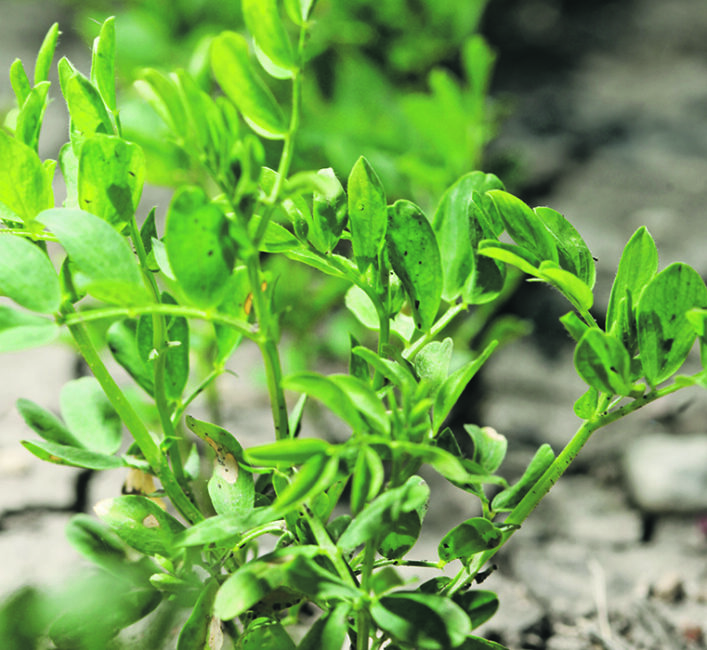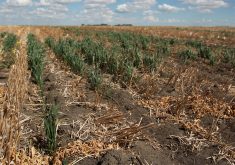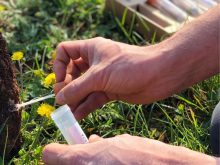Western Canadian crop rotations are being thrown off by residual fertilizer left from crops that never were
A good portion of the plant nutrients applied last spring still sits in prairie soils.
Some agronomists have even found granular pellets of fertilizer still intact when taking soil tests this fall.
In most areas, there was enough moisture to dissolve fertilizer applied in the spring. However, drought conditions prevented crops from using these inputs across wide swaths of the Prairies last summer.
With fertilizer prices shooting for the moon, many producers will be eager to include high levels of residual nutrients when penciling in their fertility program.
This is especially the case with nitrogen that’s approximately double the price now compared to a year ago.
To help growers understand the mechanism by which applied nutrients can be retained or lost, Manitoba soil fertility specialist John Heard participated in an online discussion.
He said there is much more nitrogen left over in Manitoba fields compared to an average year.
Agvise Laboratories provided a snapshot of the samples it tested this fall on its website.
Soil samples taken on wheat stubble in Manitoba show a significant number of fields have more than 100 pounds per acre of residual soil nitrate at soil depths of zero to 24 inches, including 44 percent of the fields tested in the south Interlake region.
The average nitrate level of all fields tested in the southeast region of Manitoba was 95 lb. per acre of residual nitrogen.
“Typical rates or what we would expect to see year in year out is somewhere between 30 to 40 lb. residual (nitrogen on wheat stubble),” Heard said.
“In Western Manitoba, there were some areas out there that did receive some good and timely rains, that got some good yields and some good removals and so I’m not surprised to see some of their soil test levels coming in closer to normal.”
He said there is a wide diversity of how much residual nitrogen is left in fields, which speaks to the importance of soil testing.
Most of the nitrogen applied last spring was converted to nitrate, but many areas did not receive enough moisture for leaching to occur.
“Soils were not saturated enough for denitrification. So that was really not a pathway of loss this year,” Heard said.
“We suspected that it was so dry this year that during the dry period of year it actually depressed microbial activity, and enough so that we’re wondering if we triggered this Birch effect.”
The Birch effect occurs when microbial activity is restricted in parched soils, and when it is rewetted, there is a burst of decomposition, mineralization and release of inorganic nitrogen and CO2.
“We might have a lot of those bacteria microbes desiccate or are killed, but some survive and upon initial wetting they feast upon those dead bodies of their former colleagues and there’s a flush or release of nitrate nitrogen that can be detected both by the soil test and plants if they happen to be growing,” Heard said.
This short-term burst of nitrate tends to return closer to normal levels once that nitrate is re-immobilized by microbes.
The Birch effect has the potential to create the impression during fall soil testing that there’s ample nitrogen in the soil for the following year’s crop, but spring nitrogen levels may be different from those detected in the fall.
“I’m thinking that this is probably minor compared to the big rates of nitrate that are left just because of poor crop growth and removal,” Heard said.
“But I have spoken to a few agronomists that took samples in the dry period that had one nitrate level, and then after rewetting they were seeing some of this 30 lb. (per acre) increase in nitrate that may be an artifact of this Birch effect.”
Another fertility phenomenon that can show up in dry times in fields with lots of nitrogen is called haying-off, where the crop grows aggressively and consumes scarce moisture during the vegetive growth stage, leaving little for grain-fill.
Heard said this process is something that can be observed in Australian fields during droughts.
“They often see down there that they get lower yields from these highly fertilized fields, than where it’s modestly fertilized that leaves some water remaining for grain filling,” Heard said.
He said one of the dark horses this year is what happened with mineralization, which has the potential to temporarily tie up a considerable amount of nitrogen.
“With less straw being produced with a lot of short crop cereals, certainly there’s less of that straw remaining to immobilize or sap up leftover nitrate,” Heard said.
He said a rule of thumb is that each ton of straw will immobilize about 30 lb. of nitrogen.
Even though nitrogen is not permanently lost, it will likely be hidden from the soil test and from early season crop growth.

If straw was baled and taken off there will be even less material to take part in any immobilization of nitrogen.
Jeff Schoenau, professor of soil fertility in the department of soil science at the University of Saskatchewan, participated in the Sask. Pulse 2021 Pulse Agronomy Workshop. He said the levels of residual nitrogen apparent on field in fall could be different compared to what is plant available in the spring.
“You do want to be cognizant that you didn’t lose a lot of available nitrogen. Because if there are really wet conditions in the spring, things may change a little bit, and so for that reason I think it’s always good to do a bit of checking,” Schoenau said.
He said once nitrogen levels get up around 30 lb. per acre, including residual and applied nitrogen, there will begin to be a reduction in the amount of nitrogen derived from fixation from pulse crops.
So, on fields with high levels of residual nitrogen it’s likely a better economic decision to plant crops that can’t fix their own nitrogen including a cereal or oilseed.
Schoenau said there can be negative outcomes when growing pulses on fields with high levels of residual nitrogen.
“I’ve seen pulses growing on soils with high available N, on a fallow is a good example, you get this really heavy vegetative growth that tends to fall over and lodge, in some cases with increased disease incidents,” Schoenau said.
Charles Geddes, research scientist at Ag Canada, presented at the same Pulse Agronomy workshop, and he said growers should keep in mind how high residual nutrient levels can affect weed populations.
Some of the work Geddes performed for his PhD examined volunteer canola in soybeans and he found nitrogen levels in the soil was one of the driving factors for interference from volunteer canola.
As nitrogen levels increased, yield losses imposed by volunteer canola also increased.
“Most weeds are nitrophilous, where they do prefer higher nitrogen environments, especially in our arable cropping systems,” Geddes said.
“So, if you’re planting the legume or pulse crop on a field with lower residual nitrogen you can just give that crop a bit of a competitive advantage because it’s, in part, fixing its own nitrogen, whereas the weeds will be nitrogen starved.”
Another factor to consider when it comes to residual nutrients was the regrowth that was a common sight in many growing regions last fall.
Heard said in a wet environment regrowth could act as a cover crop and provide some benefits including reducing nitrogen losses to leaching or denitrification.
But in dry environments this regrowth can use up valuable water and reduce the amount of residual nutrients that could have been used by the crop the following year.
Established nitrogen uptake patterns can be used to calculate how much nitrogen is taken up by crop regrowth.
For wheat and canola, a good portion of the nitrogen uptake occurs relatively early in the crop’s life cycle compared to other crops.
“Between tillering and stem elongation, three to five weeks after seeding or germinating or regrowing…. For cereals, it could be anywhere between 25 and 80 lb. of nitrogen per acre,” Heard said.
“With canola getting up to the early rosette stage, 15 to 70 lb. So, that could be quite a bit of nitrogen, using a back of the envelope calculation.”
To gauge how much nutrients pilfered in the volunteer canola regrowth researchers entered a canola field that wasn’t worth harvesting near Brunkild, Man.,, but had significant regrowth later in the fall.
Heard said there was on average 1.9 tons per acre of biomass and up to 21.6 tons per acre in some of the heavy areas.
“The nutrient concentration in this foliage was quite high and probably a bunch of that was a nitrate carry over and so it was readily taken up,” Heard said
“There’s 160 lb. of nitrogen, 30 of phosphate, quite a bit of potassium. If I just look at the nitrogen and phosphate cost, that is a lot of dollars’ worth of nitrogen and phosphorus.”
At current market price for nitrogen and phosphorus, he said that the canola regrowth he examined used around $135 per acre of these nutrients.
“We really don’t know how to account for cover crops or volunteer nutrients (cycling). We know that full amount isn’t available next year. It still needs to break down and decompose,” Heard said.
Researchers also went into a harvested oat field with high levels of regrowth this fall.
“In this case that’s about a tonne per acre (of biomass), and we looked at the uptake. There’s about 80 lb. of nitrogen and 85 lb. of potash…. They’re not even quite at the boot stage yet and again, some high dollar value of nutrients in that crop.”


















